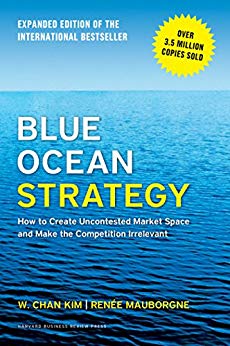

This article is an excerpt from the Shortform summary of "Blue Ocean Strategy" by W. Chan Kim and Renee Mauborgne. Shortform has the world's best summaries of books you should be reading.
Like this article? Sign up for a free trial here .
What is Blue Ocean Strategy about? What is the key premise of W. Chan Kim and Renée Mauborgne’s blue ocean business model?
In Blue Ocean Strategy, W. Chan Kim and Renée Mauborgne argue that the key to building a successful business is to create a blue ocean—a brand-new market for an innovative idea. You can create such a market by focusing on your product’s characteristics that customers really care about while discarding the characteristics they don’t. This creates a new product offering that doesn’t currently exist, in a space without direct competitors.
Here is our review of Blue Ocean Strategy.
About the Authors
W. Chan Kim is a professor of business strategy and international management at INSEAD. He is co-director of the Blue Ocean Strategy Institute within INSEAD and also a fellow of the World Economic Forum. Renee Mauborgne is Kim’s former student and now colleague at INSEAD. In 2019, Thinkers50 ranked them the #1 most influential thinkers in the field of business management.
The Book’s Publication
Blue Ocean Strategy was published in 2004 by the Harvard Business Review Press. It was the authors’ first book and a culmination of their work on the subject of “value innovation,” some of which they published in scholarly articles between 1997 and 1999.
In 2017, they published a sequel titled Blue Ocean Shift, reiterating the central message of Blue Ocean Strategy and providing additional insight based on the experience of companies that applied the strategy since it was first published.
Historical and Intellectual Context
From about 1980 to the early 2000s, most influential writings on business strategy focused on competition. The authors credit Michael Porter and his book Competitive Strategy for ushering in this age of focus on competition, although many others contributed to it as well.
Against this backdrop, Blue Ocean Strategy represented a new direction in business strategy, focusing on developing uncontested markets instead of beating the competition.
However, many of the ideas it presented were not entirely new. In Positioning: The Battle for Your Mind (published in 1980) Al Ries and Jack Trout argued that the key to successfully marketing a product was to find or create an open market sector where your product would stand out as the clear leader. Functionally, this concept is very similar to Blue Ocean Strategy.
Similarly, in 1991, marketing consultant Geoffrey Moore published Crossing the Chasm, a strategy for introducing high-tech products into the mainstream market. Moore’s strategy could almost be considered a specific application of Blue Ocean Strategy to high-tech products.
However, despite their functional similarities, Moore and Kim presented their respective strategies using very different analogies: Kim and Mauborgne’s blue ocean metaphor emphasizes an absence of competition, while Moore illustrated his strategy using the D-Day invasion of World War II, focusing on the conflict of competition. The different metaphors reflect fundamental philosophical differences between the two strategies.
The Book’s Impact
Blue Ocean Strategy was well-received worldwide. It has sold more than four million copies and was listed among the best business books of 2005 by many influential publications, including The Wall Street Journal, Business Week, and Fast Company Magazine. It is rated 4.6 out of 5 stars on Amazon and 4 out of 5 on Goodreads.
Many reviewers praised the book for addressing the problem of fierce competition with a strategy that made sense and was well presented. The visual metaphor of bloody red oceans representing fiercely competitive markets contrasted with pristine blue oceans representing uncontested markets resonated powerfully with many reviewers.
Critical Reception
Blue Ocean Strategy reviews were largely positive, but it was not without its critics. Critical reviewers often focused on the examples, saying they were merely anecdotes that were cherry-picked to provide an appearance of support for its principles. They asserted that there were no actual case studies of companies that had intentionally and successfully implemented the principles of the strategy.
Critics also pointed out that none of the ideas in the book were really new. Some reviewers went so far as to say that the only blue ocean the authors created was the one for their own book: They compiled well-known principles from the last 20 years of marketing strategy and rebranded it with a new visual metaphor that made them look superficially different from all the other market strategists of their day.
———End of Preview———

Like what you just read? Read the rest of the world's best summary of "Blue Ocean Strategy" at Shortform . Learn the book's critical concepts in 20 minutes or less .
Here's what you'll find in our full Blue Ocean Strategy summary :
- What blue oceans are, and how you create one for your business
- Why some businesses succeed in creating blue oceans, and why others fail
- The red ocean traps you have to avoid if you want business growth






